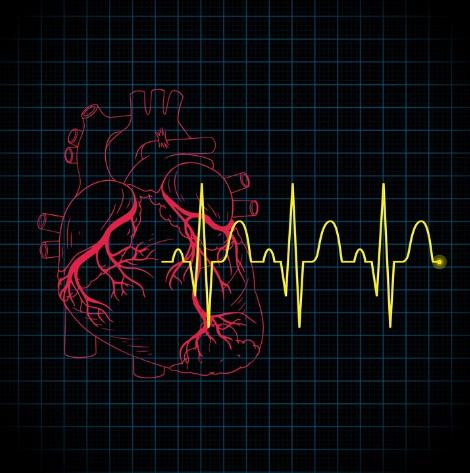Have you ever stared at an ECG strip and thought, “What am I even looking at?” You’re not alone. ECGs are one of the most intimidating parts of NREMT test prep, especially for paramedic candidates. The waveforms, intervals, and fast decisions can overwhelm even experienced students, but here’s the good news: interpreting ECGs is a learnable skill and once you understand how NREMT ECG questions are built, you’ll stop guessing and start answering with confidence.
These questions aren’t just about naming a rhythm. They test your ability to assess, interpret, and act, the same way you would in a real emergency, and that’s why it’s so important to study ECGs in a way that mirrors real patient care, not just flashcards and definitions.
In this guide, we’ll show you what types of ECG questions show up on the test, how to study smarter, and how our method can help you pass faster.
1. What the NREMT Expects from ECG Interpretation
The NREMT paramedic prep course emphasizes ECG interpretation as a core skill. Here’s what the exam focuses on:
·Recognizing basic and advanced rhythms
·Identifying life-threatening patterns (e.g., V‑fib, asystole)
·Deciding correct treatment (e.g., defibrillation vs. pacing)
·Assessing rate, rhythm, and waveform intervals
They don’t just test recognition; they test your judgment. Questions often end with, “Your next action?” That must be the right one.
2. Common ECG Question Types on NREMT
NREMT ECG questions fall into several familiar categories:
· Rhythm ID
o Atrial fibrillation vs. atrial flutter vs. SVT
o VFib vs. VTach vs. torsades de pointes
• Rate & Interval Analysis
o Bradycardia or tachycardia identification
o PR interval prolongation (AV block)
• Waveform Pattern Recognition
o ST‑segment elevation (STEMI), depression
o Q‑waves indicating old infarction
• Treatment Decision
o Cardioversion, defibrillation, pacing
o Medication choices (e.g., amiodarone, adenosine)

3. Rhythm Identification: The Foundation
This is where most candidates freeze. You’re handed a strip and asked, “What’s the rhythm?” And suddenly all those P-waves, QRS complexes, and intervals blur together.
Here’s the truth: rhythm recognition isn’t about memorizing every strip you’ve ever seen. It’s about pattern recognition. The NREMT doesn’t expect you to be a cardiologist; they expect you to identify the life-threatening rhythms that require immediate action.
Why it matters on the NREMT:
Rhythm questions show up often, especially on the NREMT cognitive exam for paramedics. These questions test if you can quickly identify and respond to critical conditions like V-Fib, V-Tach, or A-Fib. That means you need to understand what you’re seeing and what to do about it.
Before jumping into treatments, you need a rhythm ID system. We teach our students to always start with these four elements:
• Rate: Fast? Slow? Normal?
• Rhythm regularity: Is it consistent or irregular?
• QRS width: Narrow or wide?
• P-waves: Are they present and before each QRS?
Once you break it down this way, the chaos becomes clear. Below are the rhythms you’re most likely to see on the test and what to do when you see them:
|
Rhythm |
ECG Features |
Treatment Action |
|
Sinus Bradycardia |
Rate <60 BPM, P-wave before each QRS, regular rhythm |
Monitor; consider atropine if symptomatic |
|
Sinus Tachycardia |
Rate >100 BPM, normal PQRST pattern |
Treat underlying cause (pain, fever, shock) |
|
Atrial Fibrillation |
Irregularly irregular, no distinct P-waves |
Anticoagulation, rate control |
|
Ventricular Tachycardia |
Wide QRS >0.12s, regular, 140–250 BPM |
Immediate defibrillation if pulseless |
|
Ventricular Fibrillation |
No recognizable waves, chaotic baseline |
Immediate CPR and defibrillation |
Keep in mind: identifying the rhythm is only step one. The next step is knowing exactly what action to take because that’s what the NREMT is really testing.
4. Rate and Interval Measurements
Sometimes the prompt simply asks, “What is the rhythm rate?” Or, “What does this PR prolongation indicate?” Understanding intervals is essential.
|
Measurement |
Definition |
Normal Range/Interpretation |
|
Rate |
Beats per minute |
Bradycardia (<60), normal (60–100), tachycardia (>100) |
|
PR Interval |
Start of P wave to start of QRS |
0.12–0.20 seconds; >0.20 indicates AV block |
|
QRS Duration |
Start to end of QRS |
<0.12 seconds; wide suggests conduction delay |
|
QT Interval |
Start of QRS to end of T wave |
QTc <0.44 sec; prolonged risk for torsades |
Feel confident using these values on test day.

5. ST‑Segment and Pathology Identification
ST deviations may signal ischemia or infarction. You’ll need to:
• Spot STEMI: ST‑elevations ≥1 mm in two contiguous leads
• Recognize reciprocal changes (ST depression on opposite leads)
• Identify non-STEMI presentations (ST depression or T-wave inversion)
The test often asks, “What territory is affected?” or “What system do you alert?” Recognizing leads ties rhythms to anatomy.
6. Treatment Decisions: From Recognition to Action
Reading a rhythm is just the start. What truly matters, especially on the NREMT cognitive exam, is what you do next. You might see a question like:
“A patient presents with wide-complex tachycardia and a pulse. What’s your immediate action?”
This is where test anxiety kicks in. However, the NREMT isn’t trying to trick you, they want to see if you understand treatment pathways based on what the monitor shows and how the patient looks.
And yes, these are high-stakes scenarios. Missteps in real life could harm your patient. That’s why the test leans heavily on clinical decision-making. Not just “What is this?” but “What’s your next move?”
Here are some common rhythm-based decision points that show up on the exam:
• SVT in a stable patient
Start with vagal maneuvers. If that doesn’t work, give adenosine.
• Atrial fibrillation with RVR (Rapid Ventricular Response)
Focus on rate control. IV beta-blockers or calcium channel blockers are appropriate unless the patient is unstable.
• Wide-complex tachycardia with a pulse
Always assume VT until proven otherwise. Avoid hesitation—initiate synchronized cardioversion if unstable.
• Pulseless VT or VF
Go straight into high-quality CPR and defibrillation. Don’t wait. This is a shockable rhythm.
These scenarios don’t require you to memorize every drug and dose, but they do require you to understand the logic behind emergency care, and that’s where solid NREMT test preparation makes all the difference.
7. Clinical Scenario Walk‑Through
A sample question:
You arrive at a 65-year-old with crushing chest pain. ECG shows ST elevations in V2–V4. What’s next?
First scan rhythm and ST-elevation. V2–V4 indicates anterior STEMI. Next steps:
• Apply oxygen if needed
• Initiate aspirin
• Alert hospital for cath lab
• Prepare for transport and consider nitro if stable
This mirrors real calls far from memorization.

8. Interactive Strategy: Practice with Intention
To master ECGs, we recommend this method:
1. Identify the rhythm (rate, regularity, width)
2. Interpret pathology (ST changes, intervals)
3. Decide action (meds, defib, alerting)
4. Confirm using NREMT paramedic prep course protocols
5. Reflect on reasoning and question feedback
This slow-thinking system sharpens fast review later.
9. TEI Formats in ECG Questions
Like other sections, ECG questions may use Technology Enhanced Items. Common examples:
• Build‑List: Order treatment steps
• Drag‑and‑Drop: Match rhythms to treatments
• Checkbox Tables: Identify features in a rhythm
Example: A checkbox might ask, "What are features of ventricular tachycardia?"
• Wide QRS
• Rate > 120
• Normal P‑QRS relationship
Practice each TEI format to avoid surprises.
10. How Paramedic Tutoring Elevates Your ECG Game
If you’re stuck on rhythm ID or treatment logic, paramedic tutoring is a game-changer. Tutors help with:
• One‑on‑one rhythm review
• Live walkthroughs of tricky TEI items
• Building structured study routines
• Boosting confidence through guided repetition
We partner you with tutors who’ve passed the exam and run calls themselves.
11. Building Confidence Through Repetition
ECG mastery demands repeated exposure.
• Flashcard sets with rhythm strips
• Weekly rhythm quizzes
• Daily 10-minute TEI drills
Consistency builds speed, accuracy, and confidence. Soon you see subtle differences without even thinking.
12. Integrating ECG Study into Broader Prep
Your NREMT prep class shouldn’t be an isolated module. ECG fits within full patient assessment flow. Practice integrating ECG interpretation into scenarios:
• Assess ABCs
• Check rhythm strip
• Decide intervention
• Document action
That model reflects test structure and real-world workflow.
13. Final Test-Taking Tips for ECG Questions
As exam day nears:
Prioritize rhythm strips first
Use process of elimination
Don’t overthink distractors
Stick to basic intervention logic
Use calm pacing; don’t rush TEIs
Remember, the test reflects field decisions, not trivia.

FAQs
Q: How many ECG strips should I review before test day?
A: Aim for at least 100–150 variety strips. Cover basic and advanced rhythms, ST-segments, and interval patterns.
Q: Won’t I just memorize rhythms?
A: We teach pattern recognition building into clinical logic. You learn rhythm features and treatment decisions—not just labels.
Q: Do TEIs affect ECG scoring?
A: Yes. Interactive items like matching and list ordering are common. Practice them until each feels intuitive.
Q: Can I pass without tutoring?
A: Absolutely if you’re disciplined, but tutors fast‑track your curve by clarifying gaps, boosting confidence, and teaching efficient prep.
Q: What rhythm is hardest on the test?
A: Ventricular tachycardia with aberrancy is tricky. You’ll want repeated exposure and decision drills in clinical scenarios.
Ready to Master ECGs? Power Up Your ECG Mastery with How To NREMT
We’ve designed comprehensive support that combines NREMT test preparation, NREMT paramedic prep course, focused ECG TEI drills, and paramedic tutoring. We're your partner in making rhythm interpretation second nature. Join us today!

